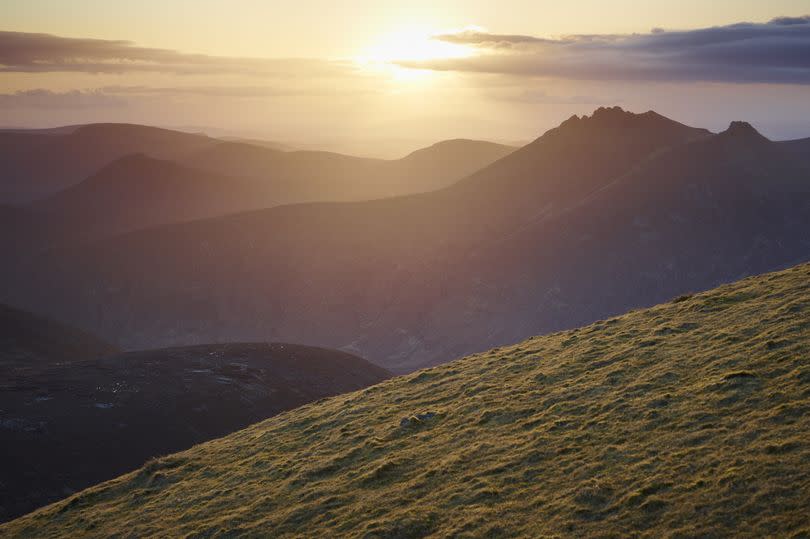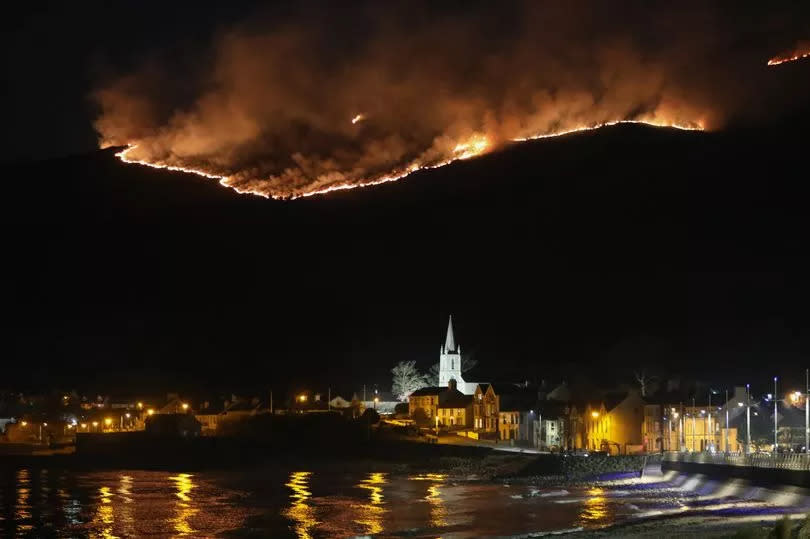Mourne Mountains: Restoration work continues three years on from devastating fire

Three years on from devastating fires, recovery work is continuing in the Mourne Mountains to help prevent wildfires and combat climate change.
In April 2021, flames ravaged 720 acres (250ha) of land in the Mournes, including part of the country’s highest peak, Slieve Donard, in what was to be one of the biggest fires of its kind recorded in Northern Ireland.
It took firefighters several days to extinguish and an area once brimming with flora and fauna was scorched, vegetation destroyed, and species diversity reduced.
READ MORE: Special cattle breed to help regenerate Mournes after gorse fires
Since then, the National Trust, which cares for much of the area, has been trialling different methods to rejuvenate the land and bring it back to full health for the plants and animals that live there.
This includes partnering with key organisations in ‘Forever Mournes’ and this week marks the first anniversary of the partnership that works to protect this landscape.
James Fisher, National Trust Ranger said: “The fire has had a devastating and lasting impact on the surrounding environment which is a precious and scientifically important area, home to a rich variety of wildlife and habitats that need care.
“Some of the measures we’re using in the recovery include re-focussing our grazing management by reducing sheep numbers and digitally analysing their grazing behaviour - this lets us better understand their impact on the habitats.
“Last year we also started using the innovative 'no fence' technology by introducing cattle to the mountain to graze the invasive course grasses that have thrived following the fire.”

Thanks to funding from Starling Bank, the National Trust ranger team have recently begun work on a long-term project which will see the restoration of deep peat habitats on Slieve Donard.
This will store carbon, slow water flow and help prevent further erosion of exposed peat. This will alleviate the threat of wildfire and benefit the species that live there including red grouse, skylark, raven and kestrel – in total about 41 hectares of land will be restored.
James explains: “Active peat forming landscapes should hold 0.7 tonnes of carbon per hectare per year and in recent years it has become apparent just how important peat forming landscapes are to combating climate change.
“Through this project, we hope to bring back healthy blanket bog, restoring it for generations to come.”
The work is also aimed at improving drought and fire resilience by holding water in the landscape during the summer.
James added: “Currently any water collected in the deep peat area of Slieve Donard quickly runs off the mountain making its way to the rivers and streams, carrying the valuable eroded peat with it and increasing the damage to the already scarred landscape.
“By constructing timber dams in the many erosion gullies found throughout the deep peat landscape on Slieve Donard we are creating shallower gradients on the exposed peat, allowing vegetation to take hold and grow.
“We will also cover the areas of exposed peat with geo-coir, a biodegradable mesh textile which holds the peat in place – this will allow seeds from the surrounding heath to grow, restoring the landscape. Retaining water in this way has the added benefit of making the landscape much more resilient to wildfire.”
The first stages of the project included transporting all the building materials to the work site, an area of deep peat located between Thomas Mountain and Millstone Mountain.
The materials included 200 8ft timber boards and 120 wooden stakes, which all had to be carried by hand. This made for difficult working conditions for the team of two mountain rangers and volunteers as the route is a 1km path from Thomas Quarry to the work site, with a vertical ascent of 210m.
Later in the year the team will install dams made from sheep wool on the shallower gradients where the flow of water is slower. These dams will be made with an outer hessian net containing the fleeces.
To minimise contamination of the habitats with seeds, agricultural chemicals or dung within the sheep fleeces, only wool taken directly from the sheep which graze on Slieve Donard throughout the summer months will be used.
James added: “The revegetation process will be further aided by planting vegetation plugs which will be sourced from the surrounding area, into the bare peat creating little islands of seed sources.
“We will be using specifically formulated grass seed mix to help the crop germinate and grow, helping stabilise the bare peat and allowing the local flora to set seed in the exposed peat.
“While these techniques are tried and tested throughout the UK and Ireland, this is the first-time timber dams have been used in the Mournes, and the first time sheep wool has been used as a damming material in the region.
“None of this work could happen without our brilliant volunteers, and of course funding from Starling Bank for the peat restoration. As a conservation charity, funding since the wildfire has been vital and we are also very grateful for the support of DAERA's Challenge Fund and Environment Fund.”
The team are heavily reliant on the volunteers to ensure the success of the project and work with the Belfast Association of Rock Climbers and Fell Runners, Mourne Heritage Trust and National Trust volunteers.
With the work ongoing throughout the year there is plenty of scope for further involvement on these exciting and interesting steps to our peatland recovery. If you would like to find out more or are interested in volunteering, please contact casey.schell@nationaltrust.org.uk.
For all the latest news, visit the Belfast Live homepage here and sign up to our daily newsletter here.

 Yahoo News
Yahoo News 
